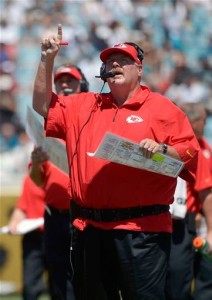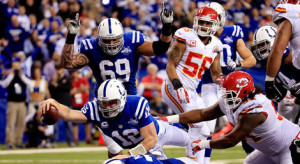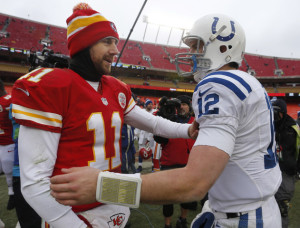Last year, Jeff Cumberland finished #2 in DVOA among all tight ends. This really happened. Of course, that required some digging, so I wrote the following about Cumberland in the 2014 Football Outsiders Almanac:
What’s going on here? How did Cumberland produce such strong numbers, and wind up second in DVOA among tight ends? Among the 52 tight ends with at least 20 targets, Cumberland ranked fifth in yards gained through the air (per reception) and seventh in yards gained after the catch (per reception). Incredibly, [Ladarius] Green ranked first in both of those metrics, but there’s generally an inverse relationship between those two statistics: you either catch passes downfield, or you gain a lot of yards after the catch, but rarely both. In fact, Green and Cumberland were the only two tight ends to rank in the top 15 in both categories, which underscores just how impressive Cumberland’s efficiency numbers were in 2013.
So is Cumberland coming off a sneaky strong season and about to break out? There’s no denying that his efficiency numbers were great, but sometimes, the best course of action is to take a step back and look at the bigger picture. In 2012, Cumberland finished second on the team with 53 targets. In the offseason, New York allowed Dustin Keller to head to Miami, but instead of handing the job to Cumberland, signed Kellen Winslow. As a result, Cumberland wound up seeing only 40 targets in 2013. If the Jets were as high on Cumberland as his numbers would suggest, he would have managed to pick up more than 2.5 targets per game in one of the league’s most anemic passing attacks. Then, New York drafted Jace Amaro in the second round of the 2014 draft. Efficiency numbers are fun to look at, but the revealed preference of the Jets organization would seem to trump those metrics. And it appears as though the organization views Cumberland as a role player and little more.
Cumberland split time with Winslow, and his low target numbers were a strong indicator that he was an average talent. Yards per target is not a good stat because it is not very sticky; yards per route run is quite a bit better. After all, a route run is more the analog of a “pass attempt” than a target, so YPRR is really the receiver’s version of yards per attempt.

The next great tight end?
This year, as he did in 2013, and 2012, and nearly in 2011, Rob Gronkowski leads all tight ends in yards per route run. He is averaging 2.67 yards per route run on his 304 routes, and the only receivers with a higher yards per route run average on over 225 routes are Demaryius Thomas (2.77) and Jordy Nelson (2.84). In short, Gronkowski is the man.
But, assuming you read the title to this post, you know that today we want to focus not on Gronk, but on baby Gronk. Kansas City’s Travis Kelce is second among tight ends in yards per route run, with a 2.49 average over 218 snaps. Those are incredible numbers, and a reflection that Kelce is already one of the top playmaking tight ends in football.
The Chiefs star hase has 542 yards on 52 targets, and his 10.4 yards/target average is the best among all tight ends. But remember, Y/T is not a good stat: Cumberland ranked 3rd last season in yards per target, with a 10.2 average. Cumberland’s issue was that he wasn’t targeted very much despite being on the field. As a result, his yards/target average overstated his value. Let’s throw some math into this equation: in 2013, Gronkowski was targeted on 30% of his routes, the best rate among all tight ends; Cumberland was targeted on 16% of his routes, the 35th best rate among tight ends.
Kelce isn’t the best receiving tight end in football because he leads with a 10.4 yards/target average. It’s not just about what you do per target, it’s how often you get targeted. As he did last year, Gronk leads all tight ends in targets per route run, as he has been targeted on 28% of his pass routes. But Kelce ranks 4th — and just a hair behind Jimmy Graham for 3rd place — in targets per route run! He’s not having a fluky season at all, or at least, not in the way Cumberland did. The Chiefs are throwing to Kelce very often when he’s running routes, which is a very good sign that he’s the real deal.
So why is Kelce “only” 6th in receiving yards among tight ends? Because he’s just 28th in pass routes run by tight ends this year. And that’s the real conundrum: he simply isn’t getting much playing time. For the 2013 Jets, Cumberland was on the field for more offensive plays than any Jets player other than the quarterback and offensive linemen. Kelce simply doesn’t get the same level of playing time, as he ranks 4th among non-OL/QBs for Chiefs offensive players in snaps.
The other problem for him is that Kansas City ranks just 31st in pass attempts this year, which is going to depress his raw totals. But the good news is his playing time is on the rise — he was on the field for 63 of 67 snaps in week 12 and 50/52 in week 11. He can’t do anything about how often the Chiefs pass, but in his case — unlike Cumberland’s — the organization seems to be buying into the numbers. Kelce’s been dominant on a per-route basis this year, and now, Kansas City keeps giving him more playing time. The next big question is whether he can maintain his level of production as a full time starter, but the hunch here is that he can. And hey, maybe we just identified the first undervalued fantasy player of 2015.







